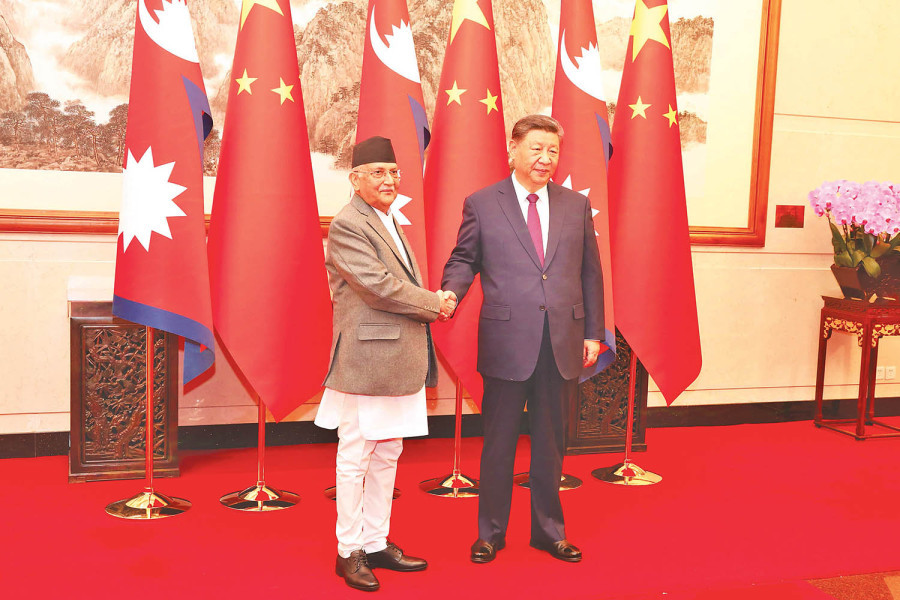Columns
Towards consensual foreign policy
The Congress and the UML should take the lead in preparing a common white paper on foreign policy.
Biswas Baral
The recent ‘framework agreement for BRI cooperation’ could be the perfect impetus for Nepal and China to kickstart the stalled BRI projects. Notably, the deal has the backing of both of Nepal’s major political forces, which together constitute nearly two-third parliamentary majority.
China’s strained relations with the Nepali Congress, the country’s biggest political party, has been a hurdle to closer bilateral ties. While Beijing sees the Congress doing the bidding of Washington and New Delhi, the Congress feels China, going beyond the bounds of diplomacy, wants to cultivate exclusive ties with Nepal’s communist parties.
The framework agreement could help change such unhelpful mutual suspicions. It was signed with the consent of the Congress. Beijing will take note.
Some may argue that there is still disgruntlement in the Congress over the agreement. But then, was the entire party on board even when the Congress leadership took the monumental decision to form a government under KP Sharma Oli’s leadership?
The other day, I bumped into a senior leader from the ‘rival’ Congress camp. As we both sipped masala tea while soaking in the winter sun, I started picking his brain.
“The Congress is divided over the new BRI agreement, isn't it?” I asked.
“These are useless murmurs of discontent inside the party,” he replied without missing a beat. “As the party functions today, if daju-bhauju want something, they get it.”
Just like the CPN-UML is a one-man Oli show these days, the Congress too is firmly under the control of the Deubas—Sher Bahadur and Arzu Rana. It was the couple who dragged the party willy-nilly into the government, and they also had the final say from the Congress on the BRI deal.
“If it’s fait accompli, why are some Kanresis still making hue and cry about the deal?” I pressed the Congress leader.
“I will tell you in one word: India.”
The southern neighbour is not happy with Nepal’s participation in the BRI. The initiative, with the China Pakistan Economic Corridor as its centerpiece, is seen as inimical to Indian interests. Kathmandu’s participation in it also threatens to yank Nepal out of India’s orbit.
A Nepal-based Indian diplomat chose to put it thus: “Look how the MCC deal progressed in Nepal. The relevant document was in public domain and the compact was vigorously debated in your parliament. Shouldn’t the same metric apply to the Belt and Road Initiative? You guys haven’t even seen any of the vital BRI documents!”
As the Congress leader suggested, if there are no new irritants in Congress-UML relations, the disagreement within the Congress over the new BRI deal could soon blow over. It should. The Deubas may have backed the framework for their personal goals. More importantly, it is also in Nepal’s interest.
If India’s repeated blockades have taught us something, it is not to rely too heavily on our southern neighbour. This, among other things, means reaching out to Beijing to build vital connectivity projects and develop new economic links.
But Nepal cannot lean too far towards China as well: We are two different societies with vastly different political cultures.
This is why we must strike a careful balance between the two neighbours—and with the new sky neighbour in the United States. But this again will be impossible if the Congress and the UML continue to wield Nepal’s foreign policy as a domestic political bludgeon. Traditionally, the Nepali communists have cottoned to China. On the other hand, the Nepali Congress has been a staunch backer of close ties with India. These party-wise leanings have done great harm to Nepal.
For this reason, the need for a consensus based foreign policy has long been felt. The country’s two biggest parties often (and naturally) found themselves in opposite benches in parliament and fought tooth and nail on foreign policy, particularly over India and China. The debates around the American MCC compact were rather acrimonious too.
Now, by sheer luck, the Congress and the UML are together in the government. This presents a rare opportunity to build broad consensus on foreign policy. Oli has gone to China and stitched together an important deal. Perhaps he can do the same with India and with Nepal’s other important international friends—again with the support of the Congress.
In this way, this ‘coalition of convenience’ for Oli and Deuba could herald an era of a more coordinated foreign policy approach. The new China deal has already given an encouraging message that Nepali political parties are capable of acting together on vital foreign policy issues.
Some may reckon many aspects of the BRI are still vague and as such Nepal should be cautious. True. Yet the current agreement also gives Nepal enough wiggle room to back out of unwanted proposals from Beijing. The ‘aid financing modalities’ can include both soft loans and grants. Based on the deal, it would be impossible for Beijing to insist that Nepal accept high-interest Chinese loans. This possibility will be further mitigated if negotiations take place on a case-by-case basis.
Principally, Nepal cannot refuse any and all kinds of loans from China—as some in the Congress argue it should—while it eagerly laps up such loans from the rest of the world. In any case, under three percent of the foreign loans Nepal has taken comes from China—less than what Japan or India have lent it. By contrast, the World Bank and the ADB contribute over 80 percent of Nepal’s loans.
As the BRI is the centrepiece of China’s foreign engagement under President Xi Jinping, Nepal cannot reject the initiative and still maintain healthy relations with Beijing. If we can agree on the right projects, there is no harm in taking some soft loans under the BRI.
Again, going beyond the BRI, the Congress and the UML should take the lead in preparing a common white paper on foreign policy—while they are still a part of the ruling coalition. History suggests this will be difficult to do when the parties are in opposition camps.




 22.64°C Kathmandu
22.64°C Kathmandu














